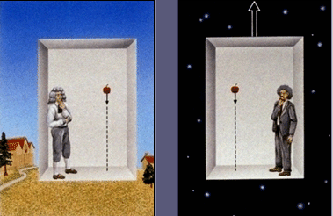

The general theory of relativity was published by Einstein about ten years after the special theory. The special theory deals only with limited reference frames: those that in uniform motion. The general theory includes those that are accelerated, as well as those in uniform motion. The most important postulate of general relativity is the principle of equivalence. It basically states that the effects of gravity and acceleration cannot be distiguished by their effects alone. Of course we know on Earth that we are being held down by gravity, but if we didn't know that we were standing on the Earth, we might think that we were being acclerated upwards, and inertia is what is holding us down.
General relativity also says that gravity is not really a force, as it is according to Newton. Newton said that all masses in the universe exert an attractive force on each other, and this is why the moon orbits the Earth, why the planets orbit the Sun, and why the sun is orbiting in the Milky Way and so on. In the general theory of relativity, however, objects always move in straight lines through space, but space is not straight. It can be visualized by imagining a sheet of fabric pulled tightly so that it is flat. It you placed a soccer ball in the middle of it, it would sag where the ball rested. If you placed a golf ball on the sheet, it would want to roll towards the soccer ball. Now this is happening in three dimensional space, which is hard to visualize, but the effects are similar. Space is not "flat", but is curved, and the amount which it curves is proportional to the mass which curves it. So while Newton said the more mass, the more force, Einstein said the more mass, the more space is curved.

The prinicpal of equivalence states that the inertial mass of an object is equivalent to its gravitational mass. This means that if we were standing in a closed room with an apple in our hand, if we dropped the apple, we couldn't tell whether the apple falls to the floor because of gravity or because the room we are standing in is being accelerated upward. It is similar to the sensation you get when you are standing in an elevator when it just starts to move. You will feel lighter when the elevator begins to go down, and heavier when it begins to go up. This is because when the elevator accelerates downward, the inertial mass of your body subtracts from the gravitational mass of your body, making you feel lighter. If the elevator were to accelerate downward at the same rate as the acclereation of gravity, i.e. freefall, you would feel weightless.

Newton's gravitation theory does not allow light to be subject to gravity, because it has no mass. The general theory, since no force is involved, does allow light to bend with gravity. This produces some interesting effects, which have been observed in nature. One such effect, which was used to verify the general theory and which made Einstein a celebrity, was the deflection of light caused by the sun. First measured in 1919, stars were observed to be shifted inwards towards the sun during an eclipse. When the sun was in a different part of the sky, the stars were in their normal positions. The amount the stars shifted matched the amount predicted by the general theory of relativity. Another consequence of light's bending by gravity are gravitational lenses. These are phenomena in which a massive object bends light in such a way that it causes a split image to appear, that is, an object appears to more than once, surrounding the central massive object. An example of this is known as Einstein's cross, a quasar that appears four times around a galaxy. In some cases, the objects would normally not be visible without the gravitational lensing effect.
Another test used to confirm the general theory of relativity dealt with the precession in the perihelion of Mercury's orbit around the sun. Newton's theory of gravity could not account for an extra 43 arc seconds of shift in the orbit. The general theory, when applied to Mercury's orbit, predicted the 43" extra measured in observations made in 1882.
Some tests of general relativity have only recently been discovered, and some haven't been observed at all. One such prediction is that of gravity waves. Strong evidence for gravity waves exists, but because gravity is so weak, it is difficult to detect, and as yet we do not have to technology to detect gravitational waves. Another prediction are black holes, which are collapsed stars which have so much mass that space time is warped significantly in their vicinity. Black holes have so much gravity that not even light can escape from them. We have good evidence that black holes exist, but we haven't conclusively proven their existence. Another prediction is known as frame dragging, which says that objects moving through space drag and twist space as they move through it. Some evidence has been found for frame dragging, and another experiment called Gravity Probe B will soon be launched to further test for frame dragging evidence.
 Drawing by Joe Bergeron, Sky & Telescope Magazine
Drawing by Joe Bergeron, Sky & Telescope Magazine
| Pre-relativity | Special | General | The Impact | Calculator | Links |